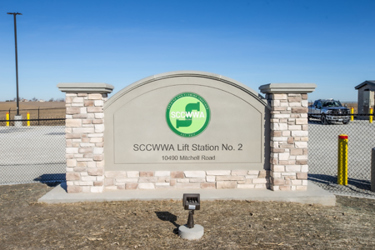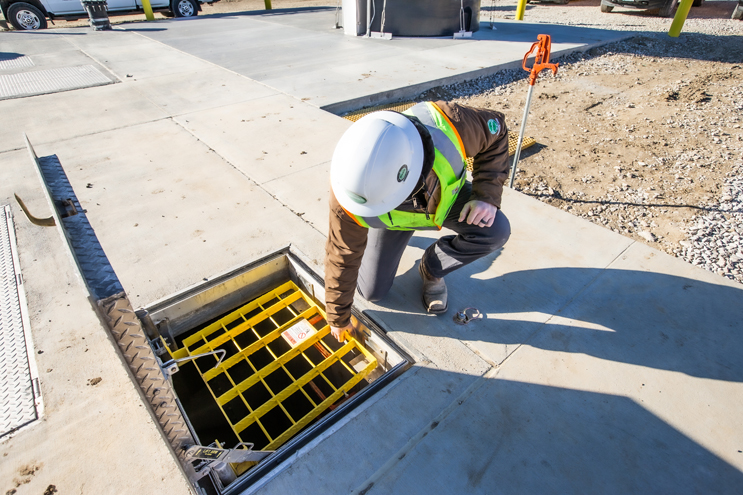Nebraska Project Opens Doors To Development
By Thomas Renner

A major infrastructure piece in the nation’s heartland completed last year is expected to dramatically transform the region with new commercial and residential development, adding millions of dollars of revenue to county and city coffers.
In December, the Sarpy County and Cities Wastewater Agency in Nebraska commissioned into formal operation the first phase of the Unified Southern Sarpy Wastewater System. The $130 million project delivered 45 total miles of sewer lines and three lift stations and is the initial step toward bringing significant development to the area. The agency expects the system, when complete, will open 97,000 new parcels for development and generate $74 million in annual sales tax revenue for the state and $60 million in annual property tax revenue for six agency members.
“This effort is a regional solution that no jurisdiction could tackle alone,” said Chairman of the Wastewater Agency and a Sarpy County Commissioner, Don Kelly. “It has taken cooperation and partnership to get here, and I’m pleased to stand alongside our neighbors to create this system that will benefit not only Sarpy County and the Omaha metro area, but the state of Nebraska as a whole.”
The project will help meet the expanding population of Sarpy County, which is the state’s smallest county geographically at 241 square miles. The county’s population, however, has nearly doubled since 2000. A hydrologic ridgeline that cuts through the county divided the region into developed northern and rural southern sections, hindered development and stifled growth for decades.
“Omaha had a treatment facility in the northern part of the ridge line,’’ said Project Engineer Jeff Thompson. “But there wasn’t a solution in the southern part of the county. Five cities and Sarpy County approached the state and asked for legislation to create a coordinated utility between all the new members of this regional system.”
Project Funding
While construction on the first phase of the system started in April 2022, the project formally began with the creation of the SCCWA in 2017. Plans for the project have been in development for decades. The government body includes Sarpy County and five cities — Bellevue, Gretna, La Vista, Papillion, and Springfield.
Funding for the project came from a $69.8 million zero-interest state revolving fund loan from the Nebraska Department of Environment and Energy. The agency also secured $4.5 million in congressionally directed spending sponsored by Congressman Don Bacon. Additional funds were acquired through low-interest loans. In all, the system is expected to cost approximately $620 million and will be built in phases over the next 10 to 50 years.
User rates and connection fees will be used to fund the system. The agency projects no property tax dollars will be used to pay for the system. Just as important, the system is expected to generate significant revenue.
According to the SCCCWA, the Sarpy County cities will generate $21 million in annual sales tax revenue and $31 million annually in property tax revenue. Sarpy County will generate another $29 million annually in property tax revenue. The state is expected to gain $74 million annually in sales tax revenue.
“First and foremost, the largest challenge was regionalization and trying to get five cities and a county to agree to collaboratively create a utility,’’ Thompson explained. “They all want development in their communities. Who comes first and how that happens was certainly a big challenge. There were also funding issues. All the cities and the county certainly didn’t have the resources to be able to provide a large bucket of money for us to pay for that. We’ve got a fair amount of debt service right out of the gate, but it’s coming together well, and we’ve got a great plan and model to keep everything on track.”
Project Scope
The project will take many more years to complete, but the critical first phase that will help launch the development in the region wrapped up in December.
The project consists of a gravity sewer system, force mains, and lift stations to get sewage across the southern part of Sarpy County.
“We’ve got about 21 and a half miles of linear distance between all of the facilities,” Thompson said. “We have two sewer lines parallel from our Springfield lift station all the way to the city of Omaha’s wastewater treatment plan. In total, we have almost 43 miles of pipe in the ground.”
The primary impediment to growth prior to the sewer line was the ridge line that divided the northern and southern sections of the county. Treatment facilities in Omaha, which will still handle some of the Sarpy County waste, served the northern section. Residences in the southern part of the county relied mostly on private systems.
“In some cases, along the top of the ridge line, development was creeping over, and the city of Omaha was servicing some of that area through localized lift stations,’’ Thompson said. “The city of Springfield had its own wastewater treatment plant.”
One other challenging aspect of the project was acquiring the land to install the sewer lines. “There were some pretty poor soil conditions, and land rights and easement acquisitions are always a challenge when you’re spanning 21.5 miles,’’ Thompson explained. “Most of it was in private agricultural fields in rural areas. Folks don’t necessarily want to give up that land. I’m happy to say we acquired a little over 100 easements and right-of-way acquisitions, and we really didn’t have a whole lot of opposition.”
Critical Maintenance
In a project of such excessive magnitude, one of the most important tasks will be system maintenance.
“The only negative part of pumping is its mechanical systems,’’ Thompson said. “We have a preventative maintenance program in place to utilize the system as efficiently as we can and keep things in good working order throughout the life of the system.”
Towards that end, the project includes 31 stainless steel floor doors from BILCO, a manufacturer of specialty access products. The doors were specified in a range of sizes, including two doors that are 55 inches by 168 inches. There are 10 doors that are 36 inches by 36 inches, and eight that are 48 inches by 72 inches. The doors are equipped with fall protection grates.

“There are only a few manufacturers in the industry that provide these types of doors for the corrosive environment,’’ Thompson stated. “BILCO was among the list specified by our engineer. They are a very solid and safe system. We wanted something that was going to provide a high level of security. We don’t want somebody falling into some of these areas. And they secure the equipment needed to facilitate the movement and conveyance of our sewers. They’re very functional and easy to operate.”
Schu Marketing of Minnesota, BILCO’s manufacturer’s representative, provided the products for subcontractor Hawkins Construction Company. HDR worked with the SSWCA to build the system.
Removing A Barrier
The system resolves a long-standing barrier to economic development in Sarpy County. It also demonstrates the ability to resolve challenges when communities work together, bringing in stakeholders from all over the area to work for the greater good.
“There was a lot of coordination with stakeholder meetings and communities at large to try to understand what made the most sense,’’ Thompson said. “At the end of the day, a lot of the politics come out of it. It was more of where things are needed, where does it make sense, and what is it most fiscally responsible for us to build. In a project of this magnitude, we had to get five communities to agree along with various other stakeholders. The five mayors of the cities and the county chairperson, they’re all great leaders. In addition, Don Kelly’s and Dan Hoins’ leadership and tenacity really brought a lot of this together.”
Thomas Renner writes on building, construction and other trade industry topics for publications throughout the United States.
